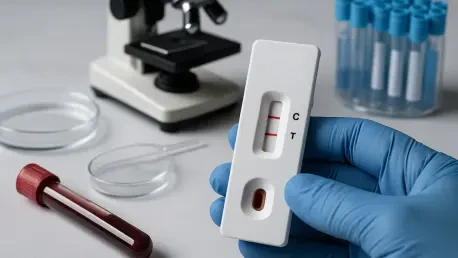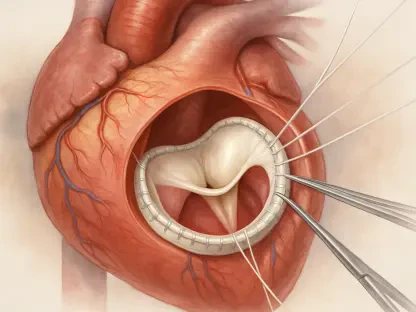In the ever-evolving landscape of global healthcare, the In Vitro Diagnostic (IVD) Test Market stands as a critical pillar, providing essential tools for detecting diseases, monitoring health conditions, and informing treatment strategies. These tests, conducted outside the human body using samples such as blood, urine, or tissue, play a pivotal role in both laboratory and point-of-care environments. As the world grapples with a rising tide of chronic and infectious diseases, the urgency for early and precise diagnostics has never been more pronounced. A recent comprehensive report underscores the market’s significant growth trajectory, revealing its indispensable role in addressing pressing public health challenges. Valued at $83.1 billion in 2024, this sector is projected to expand to $85.9 billion this year and reach an impressive $120.0 billion by 2035, driven by a steady compound annual growth rate (CAGR) of 3.4%. This remarkable ascent highlights the increasing dependence on IVD solutions to meet the complex demands of modern medicine.
Forces Behind Market Expansion
The growth of the IVD Test Market is propelled by a confluence of powerful factors shaping the healthcare landscape. Chief among them is the escalating prevalence of chronic ailments such as diabetes and cardiovascular disorders, coupled with the persistent threat of infectious diseases. These conditions necessitate frequent and reliable diagnostic interventions to manage patient outcomes effectively. Additionally, an aging global population contributes significantly to this demand, as older individuals are more susceptible to health issues that require consistent monitoring. This demographic shift places IVD testing at the forefront of healthcare systems striving to address long-term care needs. The market’s projected rise to $120.0 billion by 2035 reflects not only the scale of these challenges but also the critical reliance on diagnostics to mitigate them. Beyond mere numbers, this growth signals a broader recognition of IVD tests as foundational to preventive and reactive medical strategies across diverse populations.
Technological progress serves as another vital engine driving the IVD sector forward. Innovations in molecular diagnostics, next-generation sequencing, and artificial intelligence (AI) are revolutionizing the field by enhancing the accuracy, speed, and reach of testing capabilities. These advancements enable earlier detection of conditions, often before symptoms manifest, thereby improving patient prognosis. Moreover, they support the rise of personalized medicine, where treatments are customized based on individual genetic profiles or specific disease markers. While such cutting-edge developments promise transformative impacts, they also underscore disparities in access, particularly in regions with limited resources. Balancing innovation with affordability remains a key challenge, yet the momentum of technological breakthroughs continues to push the boundaries of what IVD testing can achieve, positioning it as a cornerstone of future healthcare solutions.
Shifts in Diagnostic Approaches
A notable transformation within the IVD Test Market is the growing emphasis on point-of-care (POC) and home-based testing solutions. This shift caters to an increasing consumer preference for convenience and immediacy, allowing individuals to obtain diagnostic results without the delays associated with traditional laboratory processes. Rapid test kits and self-testing devices are becoming more sophisticated and reliable, supported by regulatory advancements and heightened public awareness of health management. This trend not only empowers patients to take charge of their well-being but also alleviates pressure on overburdened healthcare facilities. As these accessible testing options gain traction, they are poised to redefine how diagnostics are integrated into everyday life, particularly for routine monitoring of chronic conditions or quick responses to potential infections.
Parallel to this movement is the integration of advanced technologies like AI into diagnostic frameworks, which is reshaping the accuracy and efficiency of IVD tests. AI algorithms can analyze vast datasets swiftly, identifying patterns and anomalies that might elude human observation, thus enhancing diagnostic precision. This capability is particularly impactful in detecting complex diseases such as cancer, where early intervention can be life-saving. However, the adoption of such technologies is not without hurdles, including high implementation costs and the need for robust infrastructure, especially in developing regions. Despite these obstacles, the potential of AI to streamline workflows and reduce diagnostic errors signals a future where technology and healthcare are increasingly intertwined, pushing the IVD market toward greater innovation and responsiveness to global needs.
Diversity in Market Segments
The IVD Test Market is characterized by a rich tapestry of segments, each contributing uniquely to its overall growth. Applications in infectious disease and oncology testing are at the forefront, driven by urgent public health priorities and the critical need for precise detection methods. These areas reflect the global burden of epidemics and the rising incidence of cancer, necessitating advanced diagnostic tools to guide timely interventions. Meanwhile, product categories like reagents hold a dominant position due to their essential and recurring role in laboratory testing processes. Rapid test kits, on the other hand, are experiencing a surge in popularity as POC diagnostics become more mainstream, addressing the demand for speed and accessibility in diverse settings. This segmentation illustrates the market’s ability to cater to a wide array of medical challenges through specialized solutions.
Technologically, molecular diagnostics emerges as the fastest-growing category within the IVD sphere, fueled by its unparalleled potential for early and accurate disease detection. This approach is particularly transformative in identifying genetic disorders and tailoring treatments accordingly. In terms of end-use environments, hospitals and clinical laboratories remain the backbone of high-volume testing, ensuring comprehensive diagnostic services for complex cases. However, the rise of home care as a significant growth area cannot be overlooked, as it aligns with consumer desires for at-home health management solutions. This evolving dynamic between traditional and emerging testing settings highlights the market’s adaptability, responding to both institutional needs and individual preferences while navigating the complexities of implementation across varied healthcare landscapes.
Global Perspectives and Regional Growth
Examining the IVD Test Market through a regional lens reveals a complex yet interconnected global framework. North America maintains a leading position, bolstered by its advanced healthcare infrastructure, substantial investment in research, and favorable reimbursement policies. This region benefits from a mature market where cutting-edge technologies are readily adopted, though it faces potential saturation in certain segments. Europe follows closely, with growth underpinned by strong governmental support for preventive care and robust regulatory frameworks, although bureaucratic challenges can sometimes delay the rollout of innovative diagnostics. Both regions exemplify how established systems can drive market stability while continuously pushing for advancements in diagnostic capabilities.
In contrast, the Asia-Pacific (APAC) region stands out as the fastest-growing area, propelled by escalating healthcare expenditures and a high disease burden in densely populated countries like China and India. Rapid economic development and expanding diagnostic networks further fuel this surge, positioning APAC as a hub of opportunity for IVD expansion. South America and the Middle East & Africa, while contributing smaller shares to the global market, show promising growth through increasing investments in healthcare infrastructure. Nevertheless, these regions grapple with economic constraints and logistical barriers that can hinder widespread adoption of advanced testing solutions. This diversity in regional dynamics underscores the importance of tailored strategies to address unique challenges and capitalize on localized growth drivers within the global IVD landscape.
Innovation and Competitive Dynamics
The competitive environment of the IVD Test Market is marked by the influence of major industry players such as Roche Diagnostics, Abbott Laboratories, and Thermo Fisher Scientific. These companies are at the forefront of innovation, developing high-throughput systems and rapid testing solutions that set benchmarks for quality and efficiency. Their substantial resources and research capabilities enable them to address emerging health threats and refine diagnostic precision, significantly shaping market trends. However, this dominance also poses challenges, as smaller firms may struggle to compete, potentially limiting the diversity of solutions available. Encouraging a more inclusive ecosystem where innovation from various scales can thrive is essential for sustaining long-term market vitality and addressing a broader spectrum of healthcare needs.
Looking ahead, the future potential of the IVD sector hinges on its ability to navigate both opportunities and obstacles. Personalized medicine, rapid testing advancements, and molecular technology breakthroughs present significant avenues for growth, particularly as global health priorities shift toward early diagnosis and tailored treatments. Yet, issues such as stringent regulatory requirements and inconsistent reimbursement policies could temper this progress if not adequately addressed. The market’s trajectory toward $120.0 billion by 2035 reflects a robust demand that must be matched with strategic efforts to overcome barriers. As the IVD field continues to evolve, fostering collaboration between industry leaders, policymakers, and emerging players will be crucial to unlocking its full potential and ensuring diagnostics remain a cornerstone of improved health outcomes worldwide.
Reflecting on a Path Forward
Reflecting on the journey of the IVD Test Market, it becomes evident that its evolution has been shaped by an urgent need for reliable diagnostics amid rising health challenges. The sector’s climb from a valuation of $83.1 billion in 2024 to a projected $120.0 billion by 2035, with a consistent CAGR of 3.4%, mirrors the growing dependence on these tools to navigate complex medical landscapes. Technological strides, particularly in molecular diagnostics and AI, have redefined possibilities, while regional disparities highlight the need for equitable access. Moving forward, stakeholders must prioritize strategies that bridge gaps in affordability and infrastructure, especially in emerging markets like APAC. Investing in scalable POC solutions and advocating for streamlined regulatory processes could further amplify the impact of IVD tests. As global health demands intensify, ensuring that innovation translates into tangible benefits for all populations will define the next chapter of this vital market’s story.
The path ahead for the IVD Test Market calls for a proactive approach to harness its immense potential. Addressing reimbursement inconsistencies and fostering partnerships across public and private sectors will be instrumental in sustaining growth momentum. Emphasis should also be placed on educating healthcare providers and patients about the benefits of advanced diagnostics, particularly in underserved regions where awareness remains low. Supporting smaller innovators through funding or collaborative initiatives can diversify the market’s offerings, preventing stagnation and encouraging fresh perspectives. As the landscape continues to shift, leveraging data analytics to predict disease trends and tailor diagnostic solutions could offer a competitive edge. Ultimately, the focus must remain on transforming technological promise into accessible, impactful outcomes, ensuring that IVD testing continues to underpin global efforts to enhance health and well-being through 2035 and beyond.









